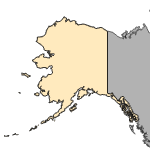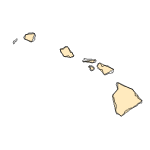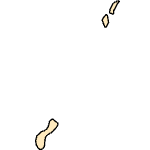Austrolebias nigripinnis
(blackfin pearlfish)
Fishes
Exotic |
|
Common name: blackfin pearlfish
Synonyms and Other Names: Cynolebias nigripinnis, (black-finned pearl fish).
Taxonomy: available through
www.itis.gov
Identification: Costa (1990) provided diagnostic characters and included this species in his identification keys to the genera and species of the subfamily Cynolebiatinae. A few distinguishing characteristics were also given in Sterba (1973). Color photographs appeared in Mills and Vevers (1989), Axelrod et al. (1985), and Costa (1990).
Size: 5 cm.
Native Range: Tropical America. Lower Parana basin, around Rio de la Plata, in Argentina and Uruguay, and an area along the Rio Uruguay floodplains, South America (Costa, personal communication).



|

Alaska |

Hawaii |

Puerto Rico &
Virgin Islands |

Guam Saipan |
Hydrologic Unit Codes (HUCs) Explained
Interactive maps: Point Distribution Maps
Nonindigenous Occurrences:
This pearlfish has been listed as a nonestablished species known from open waters in California (Courtenay et al. 1986, 1991; Williams and Jennings 1991). That listing likely is based on its introduction into experimental rice plots and ponds on lands of the Butte County Mosquito Abatement District in 1973 and 1974 (e.g., Shapovalov et al. 1981; Dill and Cordone 1997).
Table 1. States with nonindigenous occurrences, the earliest and latest observations in each state, and the tally and names of HUCs with observations†. Names and dates are hyperlinked to their relevant specimen records. The list of references for all nonindigenous occurrences of Austrolebias nigripinnis are found here.
Table last updated 12/15/2025
† Populations may not be currently present.
Means of Introduction: Intentionally stocked to assess its ability as a mosquito control agent, especially in ricefields (Dill and Cordone 1997). These studies were with the approval of the Fish and Game Commission (Dill and Cordone 1997).
Status: Failed in California. Dill and Cordone (1997) concluded that there is no evidence that the species was ever an inhabitant of open waters (see Remarks section).
Impact of Introduction: The impacts of this species are currently unknown, as no studies have been done to determine how it has affected ecosystems in the invaded range. The absence of data does not equate to lack of effects. It does, however, mean that research is required to evaluate effects before conclusions can be made.
References: (click for full references)
Axelrod, H.R., W.E. Burgess, N. Pronek, and J.G. Walls. 1985. Dr. Axelrod's atlas of freshwater aquarium fishes. Tropical Fish Hobbyist Publications, Inc., Neptune City, NJ.
Costa, W.J.E.M. 1990. Classificação e distribuição da família Rivulidae (Cyprinodontiformes, Aplocheiloidei). Revista Brasileira de Biologia 50(1):83-89.
Courtenay, W.R., Jr., D.A. Hensley, J.N. Taylor, and J.A. McCann. 1986. Distribution of exotici fishes in North America. 675-698 in Hocutt, C.H., and E.O. Wiley, eds. The zoogeography of North American freshwater fishes. John Wiley and Sons. New York, NY.
Courtenay, W.R., Jr., D.P. Jennings, and J.D. Williams. 1991. Appendix 2: exotic fishes. 97-107 in Robins, C.R., R.M. Bailey, C.E. Bond, J.R. Brooker, E.A. Lachner, R.N. Lea, and W.B. Scott. Common and scientific names of fishes from the United States and Canada, 5th edition. American Fisheries Society Special Publication 20. American Fisheries Society, Bethesda, MD.
Dill, W.A., and A.J. Cordone. 1997. History and status of introduced fishes in California, 1871-1996. California Department of Fish and Game Fish Bulletin, volume 178.
Mills, D., and G. Vevers. 1989. The Tetra encyclopedia of freshwater tropical aquarium fishes. Tetra Press, Morris Plains, NJ.
Shapovalov, L., A.J. Cordone, and W.A. Dill. 1981. A list of freshwater and anadromous fishes of California. California Fish ad Game 67(1):4-38.
Sterba, G. 1973. Freshwater fishes of the world. English translation and revision from German. Two volumes. Tropical Fish Hobbyist Publications, Inc., Neptune City, NJ.
Williams, J.D. and D.P. Jennings. 1991. Computerized data base for exotic fishes: the western United States. California Fish and Game 77(2):86-93.
FishBase Summary
Author:
Nico, L.
Revision Date: 4/30/2018
Peer Review Date: 6/28/2011
Citation Information:
Nico, L., 2025, Austrolebias nigripinnis (Regan, 1912): U.S. Geological Survey, Nonindigenous Aquatic Species Database, Gainesville, FL, https://nas.er.usgs.gov/queries/FactSheet.aspx?speciesID=880, Revision Date: 4/30/2018, Peer Review Date: 6/28/2011, Access Date: 12/15/2025
This information is preliminary or provisional and is subject to revision. It is being provided to meet the need for timely best science. The information has not received final approval by the U.S. Geological Survey (USGS) and is provided on the condition that neither the USGS nor the U.S. Government shall be held liable for any damages resulting from the authorized or unauthorized use of the information.